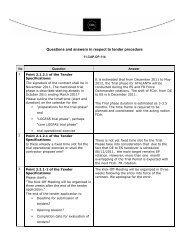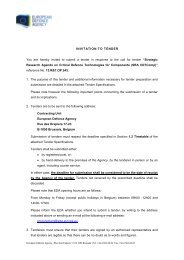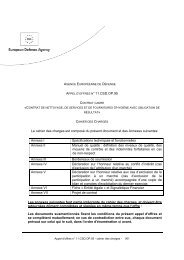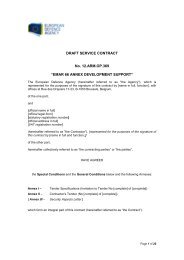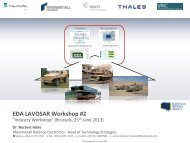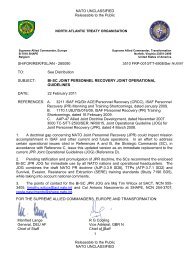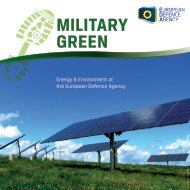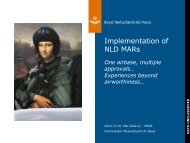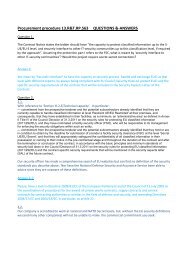capability development plan - European Defence Agency - Europa
capability development plan - European Defence Agency - Europa
capability development plan - European Defence Agency - Europa
Create successful ePaper yourself
Turn your PDF publications into a flip-book with our unique Google optimized e-Paper software.
30<br />
AN INITIAL LONG-TERM VISION<br />
FOR EUROPEAN DEFENCE CAPABILITY AND<br />
CAPACITY NEEDS<br />
b. Within a joint environment the military <strong>capability</strong> as a whole takes priority over the capabilities of the<br />
single services. Therefore standoff engagement has to become an option for all services. All military<br />
capabilities should reflect the growing likelihood and relevance of fighting within complex terrain, such<br />
as urban and littoral areas. Forces need a range of capabilities from physical destruction to non-lethal.<br />
Future operations will necessitate capabilities for precise and selective targeting and engagement<br />
thereby optimising commit-toeffect times and minimising collateral damage especially in urban areas.<br />
c. The preparation and conduct of future EU led operations will require continued consideration of<br />
space related aspects, such as communication, and the detection and identification of potential threats<br />
in advance of an appropriate response.<br />
d. Combat identification capabilities in order to reduce casualties amongst friendly forces, partners,<br />
civilians and local population are increasingly important in the complex operational environment.<br />
e. Where feasible, the EU MS must also aim to reduce the impact of military operations on the natural<br />
environment.<br />
PROTECT<br />
a. Good prior knowledge of the overall situation is a prerequisite for effective ESDP operations. Hence,<br />
it could be advantageous for MS to have access to appropriate surveillance and advanced alarm<br />
capabilities.<br />
b. It is critical to have the ability to detect, and then counter, those weapons which, for legal, moral or<br />
ethical reasons, are not available to EU MS forces (such as biological weapons) but which may be<br />
freely employed by an adversary. Thus it is important to protect our forces against the bio-hazards that<br />
they may face. High standards of casualty handling and the ability to recover stranded personnel<br />
become priorities, even in geographically remote areas.<br />
c. Recognising the expanded nature of the future battlespace, EU MS may need increasingly to<br />
safeguard networks and the area of operations against both physical and cyber attack.<br />
d. The consequences of Weapons of Mass Destruction attacks will be particularly difficult to manage.<br />
Preventing proliferation will be important as well as the ability to counter their subsequent employment.<br />
CBRN defence and protection capabilities may be essential for some ESDP missions.<br />
DEPLOY<br />
a. Deployability is the precondition for ESDP operations, including the reinforcement and sustainment<br />
of forces. EU MS should have at their disposal viable means for strategic deployability over long<br />
distances. Responsive Reception Staging Onwards movement and Integration is required to maintain<br />
tempo during operations. This requires adequate, timely and securely available air, sea and land<br />
transport capacities and procedures.<br />
b. Strategic deployment is <strong>plan</strong>ned and should be coordinated on a joint and multinational basis, using<br />
all modes of transport and available civilian resources. An ensured deployability forms the basis for a<br />
rapid, credible expeditionary <strong>capability</strong>, which should be one of the main efforts of the EU to manage<br />
crises and prevent conflicts. It will need to be based upon strategic air transport, on in-flight refuelling<br />
capabilities, and on strategic sea transport capabilities, as well as overland force projection assets.<br />
c. For intra-theatre movements, capabilities of mobility and land mobility support, tactical air transport<br />
and air mobility is a requirement.<br />
SUSTAIN<br />
a. The success of operations will also depend on the sustainability of deployed forces. Sustainability<br />
will encompass the provision, replacement and rotation of forces with the necessary means and<br />
facilities, according to operational demands. Even if the operational area is a long way from EU MS<br />
territories, sustainability must be ensured for the duration of the deployment, irrespective of the threat<br />
situation or availability of infrastructure and other factors in the operational area.<br />
b. The joint/combined support arrangements should be capable of ensuring the required quality and<br />
quantity of support over long distances and protracted timeframes. This <strong>capability</strong> may be enhanced<br />
through the provision of accurate asset visibility and tracking. Beneath that, a multinational logistic<br />
component may allow the reduction of the overall logistic footprint. Any unit has to be capable of<br />
ensuring sustainability for a limited period of time by utilising organic assets. Harmonisation, and in the<br />
longer-term standardisation, of logistic requirements and procedures may ease multinational<br />
joint/combined logistics.<br />
FUTURE TRENDS FROM THE CAPABILITY DEVELOPMENT PLAN




